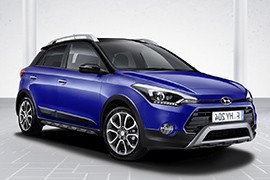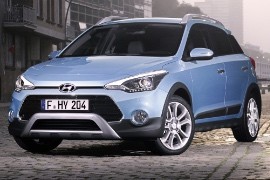HYUNDAI i20 Active Models/Series Timeline, Specifications & Photos
First production year: 2015
Engines: Gasoline, Diesel
Body style: Hatchback
The crossover small-segment was in high demand, and Hyundai tried to keep its momentum with a refreshed i20 Active that offered a few technological evolutions.
Hyundai introduced the i20 lineup in 2014 as its small-segment contender, between the city-segment i10 and the compact-sized i30. It was a suitable choice for a commuter vehicle that spent most of its time in city traffic.
The i20 Active featured the same bodywork as the i20 5-door hatchback but added specific molds from the outside. The front bumper featured an expansive, center, trapezoidal plastic mold that mimicked an aluminum shield. On the sides, the carmaker installed a set of black side-sills, which were better to stop other people's doors in the parking lot than any rock or off-road obstacle. The designers installed a redesigned bumper with a silver plastic shield underneath and two fog-lights on the outer sides in the rear.
Inside, the most significant change was the 7" touch-screen that took center stage of the dash, surrounded by a few buttons. It was Android Auto and Apple CarPlay compatible. Like in the regular i20, the climate control buttons resembled some German car. The i20 offered good interior room for four adults and a split-folding rear bench seatback that could expand the trunk area. While in an i10 that might be necessary for the weekly shopping, the i20 was didn't need if there were just two people in the house and a pet.
Hyundai installed a 1.4-liter, naturally aspirated gasoline engine paired to a six-speed manual under the i20 Active hood. It provided 100 hp, and it worked better at low-revs in city traffic.
A new vehicle on the Indian market, the Hyundai i20 Active was different from an ordinary hatchback, with a muscular and stylish design.
With SUV styling cues, the i20 was not only a looker, but also a practical vehicle with a its high ground clearance, roof rails and skid plates.
The wonderful wheel arches, stylish headlamps, the dual-tone rear bumper and the wraparound stoplights completed the exterior look.
Available only for the i20 was a new Morning Blue exterior color, for those looking to further personalise their vehicle.
Inside, the i20 was pretty much identical to the regular i20. The cluster gauges were easy to read and the controls were intuitively placed and easy to action. The cabin was roomy and the seats were comfortable.
Although the i20 could tackle some tougher roads, it was not designed for off-road and a 4-wheel-drive system was not available.
With the introduction of the new model came also a new engine, a 1.0-liter T-GDI available with 100 hp or 120 hp. The 3-cylinder unit offered a good fuel consumption and was agile enough to make a ride fun.
Another engine option was a 1.4-liter diesel unit that cranked out 90 hp, with both fuel consumption and CO2 emissions being reduced, while the Kappa 1.4-liter powerplant was a gasoline engine that developed 100 hp.

